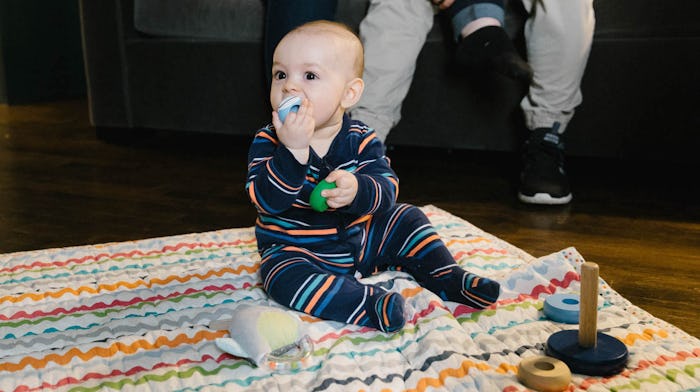Life

Here's How To Sanitize Your Baby's Most Used Items, Because They Get Gross AF
My house is probably a breeding ground for every possible germ. I like a clean home as much as the next girl, but with four boys ages eight and younger I take what I can get. I'm usually able to keep it looking presentable, but there are times when I can't remember when I last mopped the floors or really scrubbed the high chair. A little grime isn't the end of the world, of course, but this awful flu season has me worried about my infant, so I figured out how to properly sanitize baby toys and gear, to hopefully keep sickness at bay.
According to the Center for Disease Control and Prevention (CDC), there is a difference between cleaning and sanitizing, and parents should know it. "Cleaning uses soap and water to physically remove germs from the bottle. Sanitizing is an extra step to kill more germs on items that have been cleaned. Sanitizing provides more protection against all infections," the CDC website explains.
It is well known that babies explore their environment primarily by putting things in their mouths, yet even babies too young to do that come in contact with more germs than you realize through the simple ins and outs of daily life. So how often should baby items be sanitized? Fisher Price recommends it be a weekly ritual.
"Don't go crazy scrubbing your baby's toys and other play equipment too frequently, but be sure to give them a good once-over when you notice they're particularly gummed up with food or saliva," the company states. The toy manufacturer encourages parents to clean "everyday toys" weekly in addition to extenuating circumstances like after play dates or when recovering from sickness.
According to the Fisher Price website, how you sanitize toys should depend on how they are made. Plastic toys can be submerged in boiling water or run through the dishwasher. Wooden toys can't be submerged without damage, so wiping them down with a vinegar-soaked cloth should do the trick. Fabric items can go in the washing machine and dryer as long as they don't have batteries, in which case, spot cleaning will have to do. Bath toys should be soaked weekly in a 50-50 mixture of hot water and vinegar, or alternatively, run through the dishwasher. Metal cars and trains can be dunked in a mixture of bleach and water.
And what about sanitizing baby furniture like the high chair, the bouncer, and the swing? Some of the same principles apply. Remove all fabric pieces and, unless there is a battery pack inside, throw them in the washer (with a baby-safe detergent) and dryer where the heat will work its sanitizing magic. Then wipe down the item's hard surfaces with a cloth and a disinfectant. Many parents opt for an all-natural or baby-friendly brand free of hazardous chemicals, but for an even more natural, but highly effective approach, Mary Findley, cleaning expert and author recommended using a vinegar and water solution (1 part vinegar to 5 parts water) on goclean.com. "If anyone in your family has a cold or flu wipe these surface with hydrogen peroxide to kill any lingering germs." she explained. For hard to reach areas, consider using an old toothbrush to do the hard work for you.
Keeping your home sanitary is certainly beneficial in avoiding illness, but some scientific evidence suggests that its possible to go too far. Parents magazine has reported that kids who don't get enough exposure to germs may not get the practice they need battling them, resulting in immune systems that can't self-regulate. This can actually lead to autoimmune disorders like allergies or asthma.
Such information can easily make a parent feel they can't win, but as with most things moderation is probably the key. Allowing our kids to have healthy exposure to natural germs, especially through outdoor play, is important. And indoors, a once a week cleaning is probably the most any of us can realistically handle anyway.
Check out Romper's new video series, Bearing The Motherload, where disagreeing parents from different sides of an issue sit down with a mediator and talk about how to support (and not judge) each other’s parenting perspectives. New episodes air Mondays on Facebook.